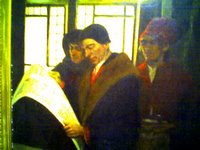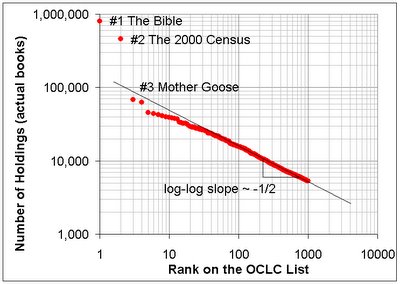 This picture from the Delaware Art Museum by Howard Pyle is entitled "Caxton at His Press" and is from a book called "The Bibliomania or Book-Madness, History, Symptoms, and Cure of This Disease" by Thomas Frognall Dibdin (note: the museum has Frogall, but wikipedia and the internet seem to suggest Frognall). It is a suitable photo for a bibliomaniac such as myself.
This picture from the Delaware Art Museum by Howard Pyle is entitled "Caxton at His Press" and is from a book called "The Bibliomania or Book-Madness, History, Symptoms, and Cure of This Disease" by Thomas Frognall Dibdin (note: the museum has Frogall, but wikipedia and the internet seem to suggest Frognall). It is a suitable photo for a bibliomaniac such as myself.BoingBoing (via Smart Patrol) points to the OCLC (Online Computer Library Center) list of the top 1000 books in OCLC member libraries. The Bible tops the list at #1 with about 800,000 library holdings (actual books). That is out of the 874 million holdings catalogued by the OCLC. This top 1000 list is about 10.5 million books and represents only 1.2% of all of the holdings. Surprisingly the 2000 Census is at #2 with 460,000 holdings.
 I took the list and performed a log-log plot of library holdings vs. the book rank so that I could see the full range of the holdings (they go from 800,000 at the top of the list to about 5000 at #1000), and to do some simple analysis. The Bible and the 2000 Census definitely stand out out of all proportion to the other books on the list. The log-log slope of -1/2 is the kind of power law distribution expected for a popularity list like this one and reflects the effect of The Long Tail (see also the blog The Long Tail). The popular books are popular but there is a long tail of books that libraries still stock because someone somewhere wants to read them. For example, the power law means that for every 4 times greater ranking (#10 to #40) there are about half the number of books at that rank(39,000 to 23,000), but this means you still have 5000 holdings down at rank #1000.
I took the list and performed a log-log plot of library holdings vs. the book rank so that I could see the full range of the holdings (they go from 800,000 at the top of the list to about 5000 at #1000), and to do some simple analysis. The Bible and the 2000 Census definitely stand out out of all proportion to the other books on the list. The log-log slope of -1/2 is the kind of power law distribution expected for a popularity list like this one and reflects the effect of The Long Tail (see also the blog The Long Tail). The popular books are popular but there is a long tail of books that libraries still stock because someone somewhere wants to read them. For example, the power law means that for every 4 times greater ranking (#10 to #40) there are about half the number of books at that rank(39,000 to 23,000), but this means you still have 5000 holdings down at rank #1000.The other books at the top of the list tend to be the classics, "The Divine Comedy", The Odyssey, The Iliad, and Hamlet. There are also children's books, Mother Goose, Huckleberry Finn, Alice in Wonderland, and the Lord of the Rings.
tags: books, art, museum, library, math, Long Tail
No comments:
Post a Comment